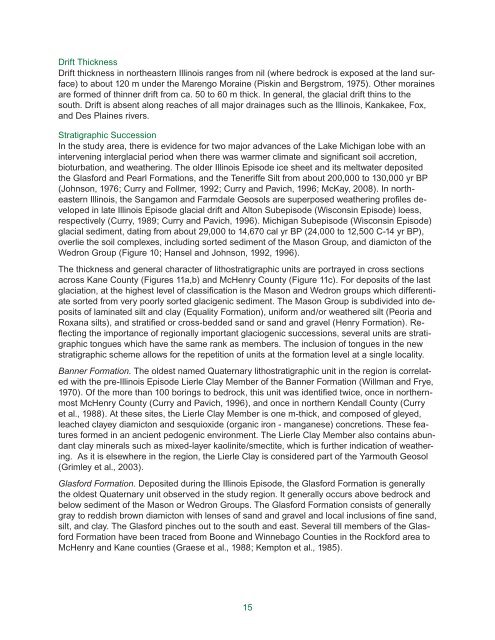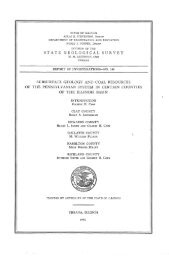illite peak (8.8°2) with thecompound kaolinite-pluschloritepeak at (12.4°2).The ratio increases upwardsthrough a weatheringpr<strong>of</strong>ile due to the loss <strong>of</strong>chlorite. Chlorite weatheringis among the first reactionsto take place in the soilpr<strong>of</strong>ile (Droste, 1956), <strong>and</strong>occurs in many places beforeleaching <strong>of</strong> carbonateminerals is complete. Lowcharge<strong>and</strong> high-chargevermiculite are products <strong>of</strong>this weathering process.Moisture content(W)302010Natural gamma-ray logging.Many lithostratigraphic unitsin the glacial drift in northeastern<strong>Illinois</strong> have characteristicdown-hole naturalgamma-ray “signatures” thatfacilitate mapping <strong>and</strong> interpretation<strong>of</strong> environments <strong>of</strong>deposition in three dimensions.The ISGS routinelyobtains downhole naturalgamma-ray logs for its deepboreholes. The logs revealthe natural radioactivity <strong>of</strong>the material surrounding00W = 0.22CL + 7.2R = 0.70Percent clay (< 2um), < 2 mm fraction(CL)Figure 9. Relationship between clay content (< 0.004 mm), moisturecontent, plastic limit, <strong>and</strong> liquid limit (after Curry, 1991) based on datacollected by the Army Corps <strong>of</strong> Engineers <strong>and</strong> the ISGS. Units lya, lyar,lyb, <strong>and</strong> lyc are facies <strong>of</strong> the Yorkville Member, <strong>and</strong> lb is the BatestownMember. See Table 2 for additional characterization data for theseunits..the boring. In northeastern <strong>Illinois</strong>, the natural radioactivity is positively correlated to clay content.Clay minerals contain relatively high concentrations <strong>of</strong> the naturally occurring radioactiveisotope <strong>of</strong> potassium, 40 K. Other sources <strong>of</strong> natural radioactivity include organic matter in paleosols(which under reducing conditions attracts <strong>and</strong> retains Uranium). The Batestown Member(Lemont Formation) is a relatively s<strong>and</strong>y diamicton unit that logs, in some areas, relatively highpossibly due to the occurrence <strong>of</strong> ultramafic minerals (Curry et al., 1999). Natural gamma-raylogs may be used to differentiate diamicton from lacustrine successions <strong>and</strong> other deposits, <strong>and</strong>indicate the top <strong>of</strong> bedrock. Moreover, events may be interpreted from logging patterns, suchas a gradual upsection shift to lower counts, indicative <strong>of</strong> decreasing clay content, <strong>and</strong> perhapshinting <strong>of</strong> an advancing ice margin into a proglacial lake (Bleuer, 2004). Such interpretations arevalidated by examining cores <strong>and</strong> cuttings.In summary, a mappable diamicton unit (formation) is characterized by its position in the stratigraphicsuccession, its relationship to moraines, color, <strong>and</strong> texture. Characterization may berefined further with mineralogical analyses, moisture content, <strong>and</strong> analysis <strong>of</strong> downhole naturalgamma-ray logs. Several units have a characteristic frequency <strong>of</strong> inclusion <strong>of</strong> bodies <strong>of</strong> sortedsediment (Curry et al., 1999), discussed below.40ly a<strong>and</strong> ly arly bly clb8014
Drift ThicknessDrift thickness in northeastern <strong>Illinois</strong> ranges from nil (where bedrock is exposed at the l<strong>and</strong> surface)to about 120 m under the Marengo Moraine (Piskin <strong>and</strong> Bergstrom, 1975). Other morainesare formed <strong>of</strong> thinner drift from ca. 50 to 60 m thick. In general, the glacial drift thins to thesouth. Drift is absent along reaches <strong>of</strong> all major drainages such as the <strong>Illinois</strong>, Kankakee, Fox,<strong>and</strong> Des Plaines rivers.Stratigraphic SuccessionIn the study area, there is evidence for two major advances <strong>of</strong> the Lake Michigan lobe with anintervening interglacial period when there was warmer climate <strong>and</strong> significant soil accretion,bioturbation, <strong>and</strong> weathering. The older <strong>Illinois</strong> Episode ice sheet <strong>and</strong> its meltwater depositedthe Glasford <strong>and</strong> Pearl Formations, <strong>and</strong> the Teneriffe Silt from about 200,000 to 130,000 yr BP(Johnson, 1976; Curry <strong>and</strong> Follmer, 1992; Curry <strong>and</strong> Pavich, 1996; McKay, 2008). In northeastern<strong>Illinois</strong>, the Sangamon <strong>and</strong> Farmdale Geosols are superposed weathering pr<strong>of</strong>iles developedin late <strong>Illinois</strong> Episode glacial drift <strong>and</strong> Alton Subepisode (Wisconsin Episode) loess,respectively (Curry, 1989; Curry <strong>and</strong> Pavich, 1996). Michigan Subepisode (Wisconsin Episode)glacial sediment, dating from about 29,000 to 14,670 cal yr BP (24,000 to 12,500 C-14 yr BP),overlie the soil complexes, including sorted sediment <strong>of</strong> the Mason Group, <strong>and</strong> diamicton <strong>of</strong> theWedron Group (Figure 10; Hansel <strong>and</strong> Johnson, 1992, 1996).The thickness <strong>and</strong> general character <strong>of</strong> lithostratigraphic units are portrayed in cross sectionsacross Kane County (Figures 11a,b) <strong>and</strong> McHenry County (Figure 11c). For deposits <strong>of</strong> the lastglaciation, at the highest level <strong>of</strong> classification is the Mason <strong>and</strong> Wedron groups which differentiatesorted from very poorly sorted glacigenic sediment. The Mason Group is subdivided into deposits<strong>of</strong> laminated silt <strong>and</strong> clay (Equality Formation), uniform <strong>and</strong>/or weathered silt (Peoria <strong>and</strong>Roxana silts), <strong>and</strong> stratified or cross-bedded s<strong>and</strong> or s<strong>and</strong> <strong>and</strong> gravel (Henry Formation). Reflectingthe importance <strong>of</strong> regionally important glaciogenic successions, several units are stratigraphictongues which have the same rank as members. The inclusion <strong>of</strong> tongues in the newstratigraphic scheme allows for the repetition <strong>of</strong> units at the formation level at a single locality.Banner Formation. The oldest named Quaternary lithostratigraphic unit in the region is correlatedwith the pre-<strong>Illinois</strong> Episode Lierle Clay Member <strong>of</strong> the Banner Formation (Willman <strong>and</strong> Frye,1970). Of the more than 100 borings to bedrock, this unit was identified twice, once in northernmostMcHenry County (Curry <strong>and</strong> Pavich, 1996), <strong>and</strong> once in northern Kendall County (Curryet al., 1988). At these sites, the Lierle Clay Member is one m-thick, <strong>and</strong> composed <strong>of</strong> gleyed,leached clayey diamicton <strong>and</strong> sesquioxide (organic iron - manganese) concretions. These featuresformed in an ancient pedogenic environment. The Lierle Clay Member also contains abundantclay minerals such as mixed-layer kaolinite/smectite, which is further indication <strong>of</strong> weathering.As it is elsewhere in the region, the Lierle Clay is considered part <strong>of</strong> the Yarmouth Geosol(Grimley et al., 2003).Glasford Formation. Deposited during the <strong>Illinois</strong> Episode, the Glasford Formation is generallythe oldest Quaternary unit observed in the study region. It generally occurs above bedrock <strong>and</strong>below sediment <strong>of</strong> the Mason or Wedron Groups. The Glasford Formation consists <strong>of</strong> generallygray to reddish brown diamicton with lenses <strong>of</strong> s<strong>and</strong> <strong>and</strong> gravel <strong>and</strong> local inclusions <strong>of</strong> fine s<strong>and</strong>,silt, <strong>and</strong> clay. The Glasford pinches out to the south <strong>and</strong> east. Several till members <strong>of</strong> the GlasfordFormation have been traced from Boone <strong>and</strong> Winnebago Counties in the Rockford area toMcHenry <strong>and</strong> Kane counties (Graese et al., 1988; Kempton et al., 1985).15
- Page 1 and 2: State of IllinoisRod. R. Blagojevic
- Page 3: Deglacial History and Paleoenvironm
- Page 6 and 7: AcknowledgementsBrandon is grateful
- Page 8 and 9: WINNEBAGOOGLEMarengo MoraineWoodsto
- Page 10 and 11: Figure 3 Projected growth areas in
- Page 12 and 13: Surficial fine-textured layerTiskil
- Page 14 and 15: samples, especially diamict units.
- Page 16 and 17: OaOgSuWINNEBAGOOgBOONE MCHENRY LAKE
- Page 18 and 19: Bedrock valley floor changes in Kan
- Page 22 and 23: Grayslake Peat (gr)Peoria Silt (not
- Page 24 and 25: DEPOSITS OF THE LAST GLACIATIONMaso
- Page 26 and 27: WisconsinCheck here ifH homestead c
- Page 28 and 29: Table 1 Summary of particle size of
- Page 30 and 31: Table 2 Selected physical propertie
- Page 32 and 33: l-h0 counts per second50Diamicton,b
- Page 34 and 35: Geochronologicand Chronostratigraph
- Page 36 and 37: Wisconsin EpisodeAthens Subepisode
- Page 38 and 39: MarengoPhaseMarengo MoraineHarvardS
- Page 40: Three erosional channels cut across
- Page 43 and 44: Boring WAD-05-02Tinley Moraine*DesP
- Page 45 and 46: Figure 30 Glacial and lake phases a
- Page 47 and 48: were not intended to overlap (North
- Page 49: West Chicago Moraine,9c Higgins/Sut
- Page 52 and 53: Benn D.I., 2002, Clast fabric devel
- Page 54 and 55: Curry, B.B. 2003. Linking Ostracode
- Page 56 and 57: Eyles, N. 1983. Glacial Geology: An
- Page 58 and 59: Hajic, E.R., 1990. Late Pleistocene
- Page 60 and 61: Johnson, W. H., A. K. Hansel, E. A.
- Page 62 and 63: Leighton, M.M., P. MacClintock, L.E
- Page 64 and 65: Piskin, K., and R. E. Bergstrom, 19
- Page 66 and 67: Vagt, P. J., 1987. Characterization
- Page 68 and 69: STOP 1: Buffalo Rock State ParkLarg
- Page 70 and 71:
ner channel began. Previously, thes
- Page 72 and 73:
Figure 3 (A) Example of outer erosi
- Page 74 and 75:
Stop 2a: Wedron Silica Company Quar
- Page 76 and 77:
N N N0.0W20.5W1W3Depth (m)1.01.5Rin
- Page 78 and 79:
0.00.2W3W2W1W1W3W2Ringshearresult0.
- Page 80 and 81:
to the arrival of the last glaciers
- Page 82 and 83:
Sedimentology and stratigraphyThe c
- Page 84 and 85:
prairie-like. Pollen analyses may b
- Page 86 and 87:
CarboniferousFigure 1 Carboniferous
- Page 88 and 89:
Figure 3 Largest and best preserved
- Page 90 and 91:
Figure 6 Small normal faults in lam
- Page 92 and 93:
and mineralogy, we propose that the
- Page 94 and 95:
Stop 4: Oswego ChannelThe 15,770 C-
- Page 96 and 97:
NewarkMarseillesIroquoisSt. AnneOsw
- Page 98 and 99:
Joliet sublobe;retreat to theValpar
- Page 100 and 101:
Sediment coresSeveral sediment core
- Page 102 and 103:
formed during the late Livingston P
- Page 104 and 105:
are being examined by Professor L.
- Page 106 and 107:
assistant secretary of the Smithson
- Page 108 and 109:
Annotated Illustrated Guide to the
- Page 110 and 111:
Figure 4 The BrewsterCreek mastodon
- Page 112 and 113:
Figure 6 The left lower 3rd molar o
- Page 114 and 115:
Figure 8 The left upper 3rd molar o
- Page 116 and 117:
Figure 10 This slide elaborates on
- Page 118 and 119:
Aurora Mastodont Project 2004 - A s
- Page 120 and 121:
a full skeleton still buried. Ed Mo
- Page 122 and 123:
Figure 17 Field leader Anita Weber
- Page 124 and 125:
Figure 18 Paleontologist For A Day
- Page 126 and 127:
paleontologist/geologist/archeologi
- Page 128 and 129:
scientific rationale behind the see
- Page 130 and 131:
tures exposed, from well drained in
- Page 132 and 133:
N1 km1 miAA’lbgphhwheA1380 lbFelt
- Page 134 and 135:
Table 1 Soil horizonation and depth
- Page 136 and 137:
Figure 5 Morphological measure of t
- Page 138 and 139:
vial upper solum characteristics, d
- Page 140 and 141:
material indicates long term disper
- Page 142 and 143:
(Table 1). Sand and silt values oft
- Page 144 and 145:
STOP 7: DeKalb moundsArchives of de
- Page 146 and 147:
acA A ‘*"e H-2278bde(x)1 kmFigure
- Page 148 and 149:
1 kmFigure 4 Typical distribution a
- Page 150 and 151:
Vertical exaggeration =20x5 mB-9AWe
- Page 152 and 153:
Valve concentration(#/gm, moist)0.0
- Page 154 and 155:
200-8Value (‰)-6 -4 -2 0 2 0.00 0
- Page 156 and 157:
sions encompass the period of final
- Page 158 and 159:
Stop 8: Spring Lake Sand and Gravel
- Page 160 and 161:
Stratigraphy and Mechanical Stratig
- Page 162 and 163:
ABCDEFFigure 3 Characteristic defor
- Page 164 and 165:
a.b.C90 mC'WED85 mD'c.D200 mD'NSd.D
- Page 166 and 167:
a.b.c.d. e.LHudSTATION E1 E2 E3LHld
- Page 168 and 169:
In the weaker units, several charac
- Page 170 and 171:
Stop 9: Thelen Sand and Gravel Pits
- Page 172 and 173:
Table 1 Lithofacies code for fluvia
- Page 174 and 175:
The erosion of the large semi-circu
- Page 176 and 177:
Topset sequences are composed of bo
- Page 178 and 179:
APPENDIX A. Description of Profile
- Page 180 and 181:
pinches out laterally.4 879.6 10.5
















